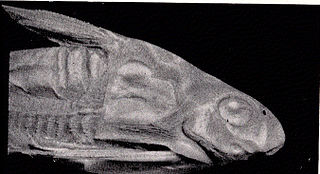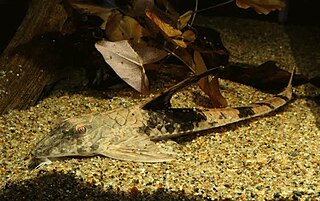
Ancistrus is a genus of nocturnal freshwater fish in the family Loricariidae of order Siluriformes, native to freshwater habitats in South America and Panama. Fish of this genus are common in the aquarium trade where they are known as bushynose or bristlenose catfish. In the aquarium hobby they are often referred to as bushynose or bristlenose plecos instead, but this may lead to confusion as "pleco" usually is used for Hypostomus plecostomus and its allies and is often used as a catchall term for any loricariids remotely resembling that species.

The Doradidae are a family of catfishes also known as thorny catfishes, raphael catfishes or talking catfishes. These fish are native to South America, primarily the Amazon basin and the Guianas.

Baryancistrus is a genus of freshwater Loricariid catfish. They inhabit flowing sections of rivers, especially clearwater, in the basins of the Amazon and Orinoco in Brazil and Venezuela. The largest species reach up to 34 cm (13 in) in total length.

Hemiancistrus is a genus of suckermouth armored catfishes. These species are native to South America. The taxonomy of this genus is complex and unclear, and major work has to be done. Many of these fish are popular aquarium fish.

The striped Raphael catfish is a catfish of the family Doradidae. It may also be called Southern striped Raphael, talking catfish, chocolate doradid, chocolate catfish or thorny catfish. It is native to the Amazon, Paraguay–Paraná and lower Orinoco basins in South America. This peaceful, nocturnal species is a popular aquarium fish due to its pleasant temperament and curious nature. Despite its name "talking catfish", it does not speak.

Platydoras costatus, the Raphael catfish, is a species of thorny catfish native to rivers in Suriname and French Guiana. It was long confused with other species in the genus Platydoras, especially the more widespread "true" striped Raphael catfish. P. costatus grows to a length of 24 cm (9.4 in) SL, and unlike P. armatulus the light stripe along the body of P. costatus does not extend onto the head. This fish is a minor component of local fisheries and is also found in the aquarium trade.

Platydoras is a small genus of thorny catfishes native to freshwater habitats in subtropical and tropical South America.
Wertheimeria maculata is the only species in the genus Wertheimeria of the catfish family Doradidae. This species is endemic to Brazil and is found in the Jequitinhonha and Pardo Rivers. These fish reach a length of 30.0 centimetres (11.8 in) SL. Within its restricted range, W. maculata faces strong human habitat disturbances such as siltation, habitat fragmentation, pollution, and introduced species. This fish has been placed as the sister taxon to all other doradids.

Acanthodoras is a genus of thorny catfishes native to rivers of tropical South America.

Doras is a genus of thorny catfishes native to tropical South America.

Anadoras is a genus of thorny catfishes native to tropical South America.
Rhinodoras is a genus of thorny catfishes native to South America.

Trachydoras is a genus of fish in the family Doradidae native to South America.
Nemadoras is a genus of thorny catfishes native to tropical South America.

Leptodoras is a genus of thorny catfishes native to South America.
Rhynchodoras is a small genus of thorny catfishes native to South America. Rhynchodoras is closely related to Rhinodoras and Orinocodoras.

Loricaria is a genus of armored catfish native to South America.
Hassar orestis is a species of thorny catfish that is native to the countries of Brazil, Colombia, Ecuador, Guyana, Peru and Venezuela. It is found in the Orinoco and Essequibo River basins. This species grows to a length of 20.6 centimetres (8.1 in) SL.
Centromochlus is a genus of fish in the family Auchenipteridae native to South America.
Ossancora is a genus of thorny catfish native to tropical South America.












